Surficial and Internal Geometry of Carbonate Eolianite in Fujian, China: Climatic and Tectonic Implications
Keywords:
Eolianite, geometry, sedimentary structure, Holocene, paleowind, Fujian, dune, monsoonAbstract
Three distinct carbonate-bearing, eolianite sand ridges (two are superimposed), of Mid- to Late-Holocene age, are located on an undulating weathered granite surface about 200 m south of Houshijing Village, Hushi Peninsula (Putian County, Fujian Province, China). The largest, and oldest, of the three coastal ridges is approximately 135 m long, 20-37 m in width, and 2-4.5 m thick. They are all elongated in a northeast-southwest direction, with cross-beds dipping perpendicular to the long axes of the ridges. The mean dip angle of the cross-beds is 16.3 deg, but 20% of the beds dip at angles > 20 deg. The sediment consists of medium to coarse quartz grains (-0.1 to 0.4 phi), and 47-67% biological carbonate fragments forming a cement in this warm, monsoonal climate. This eolianite sediment is similar in size and composition to the sediment presently composing the adjacent beaches, its former source. Root structures, typical of vegetated coastal sand dunes, are common in the ridges. The surfical and internal geometry suggest that these rocks were formed as longitudinal vegetated dunes (Ridges 1 and 2), and as a wind shadow (lee) dune (Ridge 3), from sand funnelled uphill from the beach 400 m to the northeast by the strong monsoonal winds. Similar wind shadow dunes are observed to be presently forming 400th m to the south along the cliff top adjacent to the beach. The long axes of all three ridges are clearly aligned with the present dominant northeast monsoonal wind direction, suggesting that the eolian processes have not changed appreciably along southeastern china's coast in the last 2700 years. Further, the interpretation of these features as dunes, rather than beachrock, means that no tectonic implications can be made, which is a different conclusion than had been previously suggested.


